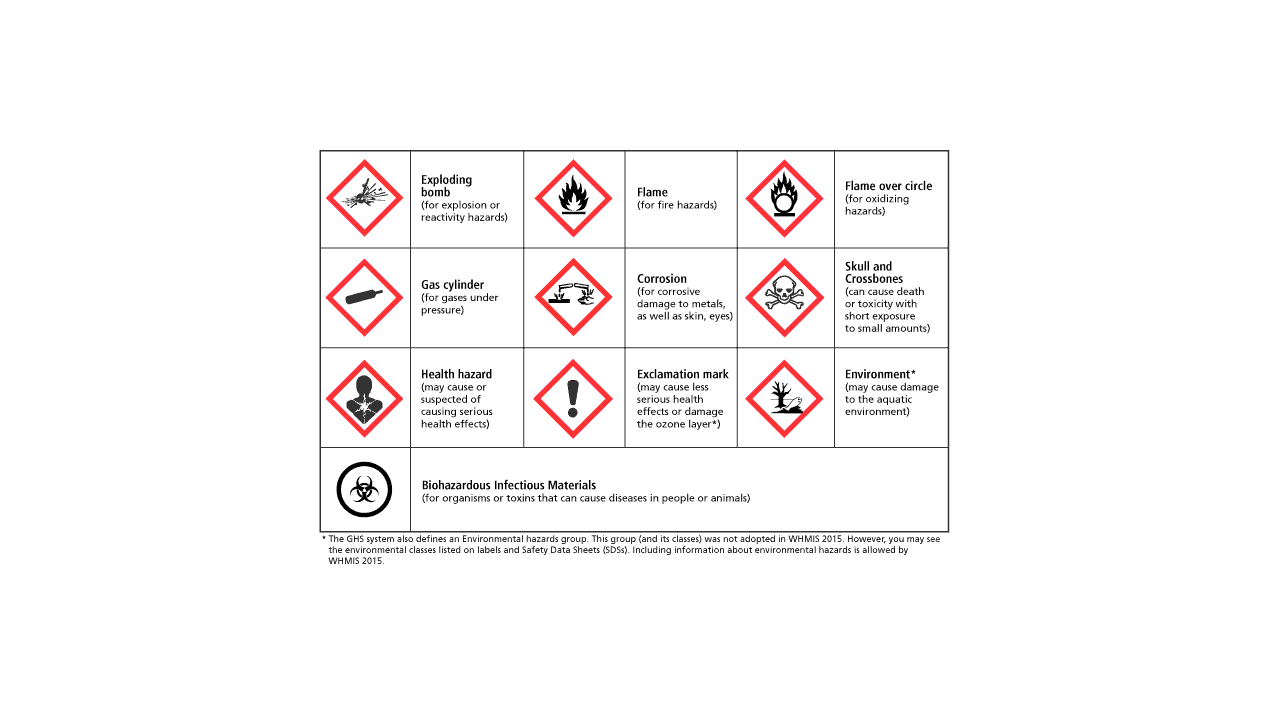3.2 - Hazardous products
A hazardous product is a product, material or substance that meets the criteria to be classified in one or more of the hazard classes of the Hazardous Products Regulations, made under the Hazardous Products Act. These can be chemicals, biologicals or other similar materials.
A product that meets any of the hazard criteria is a hazardous product. Hazardous products are subject to the SDS and labelling requirements of the Hazardous Products Act; however, there are exemptions, which are listed in section 3.3, below.
3.3 - Exemptions
The following goods are exempt from WHMIS requirements:
- Nuclear substance within the meaning of the Nuclear Safety and Control Act, that is radioactive
- Hazardous waste, being a hazardous product that is sold for recycling or recovery or is intended for disposal
- Tobacco or a tobacco product as defined in the Tobacco Act
- Pest control products as defined in the Pest Control Products Act
- Explosives as defined in the Explosives Act
- Cosmetics, drugs, devices or food as defined in the Food and Drugs Act
- Consumer products as defined in the Canada Consumer Product Safety Act
- Any wood or product made of wood
- Manufactured article
These products are governed under other legislation.
3.4 - Overview of hazard groups
WHMIS includes three hazard groups:
- Physical hazards, which represents hazards relating to physical and chemical properties, such as flammability or compressed gases
- Health hazards, which represents hazards to health arising from exposure to a substance or mixture, such as acute toxicity or skin sensitization
- Environmental hazards, which represents hazards relating to the aquatic environment or the ozone layer
Most hazard classes are further subdivided into categories and subcategories based on the severity of the hazard. The majority of categories are identified by a number while subcategories are identified by a number and letter. The lower the number, the more severe the hazard; for example, a product classified as a category 1 flammable liquid is more hazardous than a category 2 flammable liquid.
3.5 - Physical
The WHMIS 2015 physical hazard classes are:
- Combustible dusts
- Corrosive to metals
- Flammable aerosols
- Flammable gases
- Flammable liquids
- Flammable solids
- Gases under pressure
- Organic peroxides
- Oxidizing gases
- Oxidizing liquids
- Oxidizing solids
- Pyrophoric gases
- Pyrophoric liquids
- Pyrophoric solids
- Self-heating substances and mixtures
- Self-reactive substances and mixtures
- Simple asphyxiants
- Substances and mixtures which, in contact with water, emit flammable gases
- Physical hazards not otherwise classified
3.6 - Health
The WHMIS 2015 health hazard classes are:
- Acute toxicity
- Skin corrosion/irritation
- Serious eye damage/eye irritation
- Respiratory or skin sensitization
- Germ cell mutagenicity
- Carcinogenicity
- Reproductive toxicity
- Specific target organ toxicity – single exposure
- Specific target organ toxicity – repeated exposure
- Aspiration hazard
- Biohazardous infectious materials
- Health hazards not otherwise classified
In Canada, the familiar biohazardous infectious materials hazard class in WHMIS, which was not included as part of the global classification system, was retained in order to maintain existing worker protection.
3.7 - Environment
The environmental hazard classes (hazardous to the aquatic environment and hazardous to the ozone layer) were not adopted in Canada. Nevertheless, because this is a globally harmonized hazard identification system, you may see environmental hazard group pictograms on products used at uOttawa.
3.8 - Applying what you have learned
Let’s take a look at how to identify hazards associated with hazardous products by using their SDS. We will use sulphuric acid as the hazardous product in this section.
Complete this interactive activity to identify hazards using an SDS.
Accessible learning experience.


